Firefighter Survival in the Water
by Gerald M. Dworkin
February 11, 1998
In the event a firefighter is suddenly and unexpectedly immersed in deep water while wearing full turnout gear, firefighter survival is dependent upon the actions taken during the first critical seconds of the immersion.
Causes For Unexpected Firefighter Submersion
The incidence of this type of emergency increases when firefighters are fighting apartment fires around a swimming pool, during suppression activities on and around piers and docks, as well as during a fall-through incident in which the firefighter falls through a floor into a basement filled with water.
Prone vs. Supine Position
During the past several years, there has been conflicting information advocating the need for the firefighter to assume a prone (on the front) versus a supine (on the back) position in the water.
It is our belief that the firefighter should assume a horizontal position in the water as soon as he floats to the surface. Whether the firefighter assumes a prone or supine horizontal position should be dependent upon the individual comfort level of the firefighter. However, it is also our opinion that if the firefighter is wearing SCBA, as he would during suppression activities, it is safer and more comfortable for the firefighter to assume a supine horizontal position.
Supine Position Recommended If Wearing SCBA
Turnout Gear Weight Factor
Wearing full turnout gear with SCBA increases the weight of a firefighter by approximately 60 lbs. (Photo A).
When the turnout gear is wet, approximately 40 lbs. of additional weight is added as a result of the absorbed water into the pockets and lining of the gear.
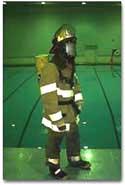
Maintain Buoyancy and Breathing Until Rescued
Yet, even with the additional 100 lbs. of weight, after the firefighter falls into the water, he will immediately float to the surface as a result of the trapped air inside his turnout gear. The firefighter can safely maintain his buoyancy in the water while working his way to safety or until he can be rescued by other firefighters. (Photo B).
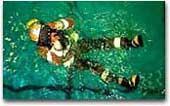
Once immersed, many airpacks will automatically free-flow air. Due to the positive pressure in the air mask, as long as the seal has not been compromised, the firefighter can continue to breathe with the mask in place.
Firefighter Survival Actions After Falling Into Water
Immediately after falling into the water, the firefighter needs to assume a horizontal position in the water. If he attempts to get vertical, all the trapped air will escape from the neck and arms of the turnout coat and the firefighter will immediately lose his buoyancy. (Photo C).
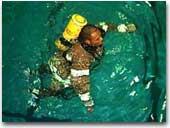
While maintaining horizontal positioning in the water, the firefighter should use only underwater arm movements to progress himself to safety. Overarm movements will again result in losing air from the turnout coat, and the weight of the arms will lead to exhaustion of the firefighter.
The firefighter’s turnout gear can assist him in staying afloat. The firefighter’s helmet can be used to trap air and when placed over the hips, will help to elevate the firefighter’s hips in the water. (Photo D).
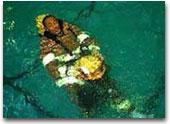
If the firefighter is wearing rubber pull-on boots, he can remove one, or both boots, empty the water from them, and then invert them to trap air. The trapped air inside the boot provides sufficient buoyancy to keep the firefighter afloat. (Photo E & F).
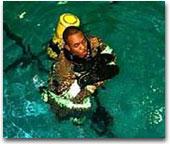
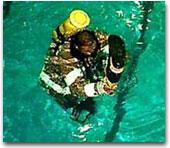
Benefits of Supine Position for Survival
It is the opinion of this author that for firefighter survival in water, the best horizontal position to assume when wearing SCBA is supine (on the back). This allows the firefighter to assume a good horizontal position with the toes of his feet near the surface in order to trap air in his boots. It also provides the best advantage for seeing his surroundings, as well as for using the underwater arm movements.
Should the firefighter need to dump his SCBA, the supine position allows the firefighter the best access to his SCBA straps. (Photo G). Should additional air need to be added within the turnout coat, this can easily be done with the firefighter in this position by splashing water into the bottom of the turnout coat.
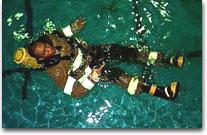
Dangers of Prone Position
Some authorities recommend a prone (on the front) position. However, by doing so, the SCBA bottle prevents the firefighter from removing his head from the water, especially if he is still wearing his helmet. Furthermore, by overcompensating and lifting his head higher out of the water, this tends to place him in a more vertical position which results in his losing trapped air from the turnout coat. (Photo H).
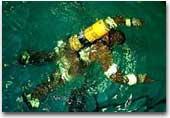
Practice = Survival
We encourage all Fire and Rescue Departments to provide the opportunity for firefighter personnel to practice these survival procedures while wearing full turnout gear. These practical evolutions should be performed in shallow water under the watchful eye of an Instructor.
After these skills are mastered and the firefighter is comfortable in the water with his gear, these skills should then be practiced in deep water. We recommend these skills be practiced by one firefighter at a time in the water along with an in-water Instructor. The in-water Instructor should have a buoyant device (i.e. Rescue Tube) available should the firefighter panic and/or lose his buoyancy.
Firefighter Survival in Water Video Demonstration
The video below features Gerry Dworkin providing examples of firefighter survival techniques after falling in water.

